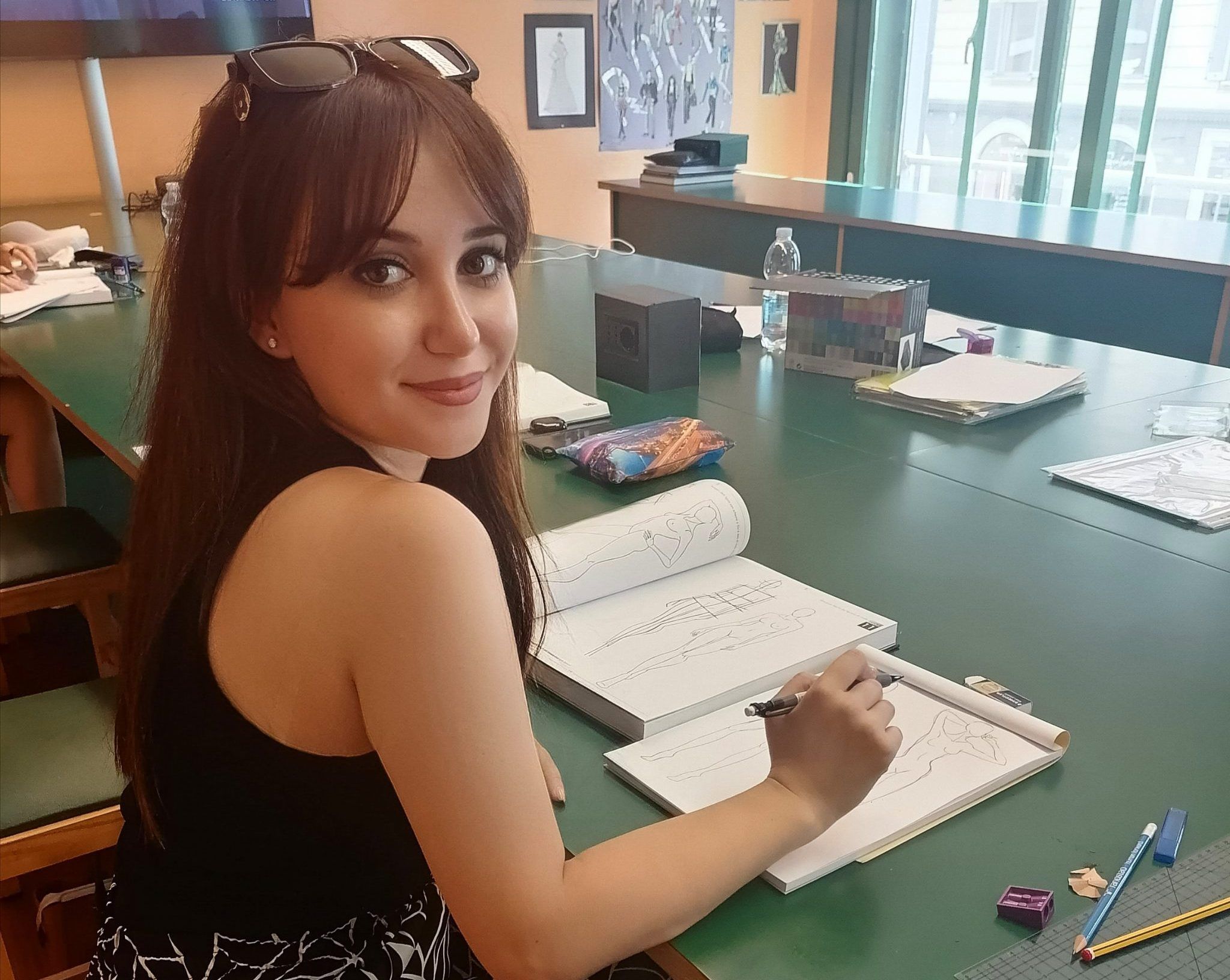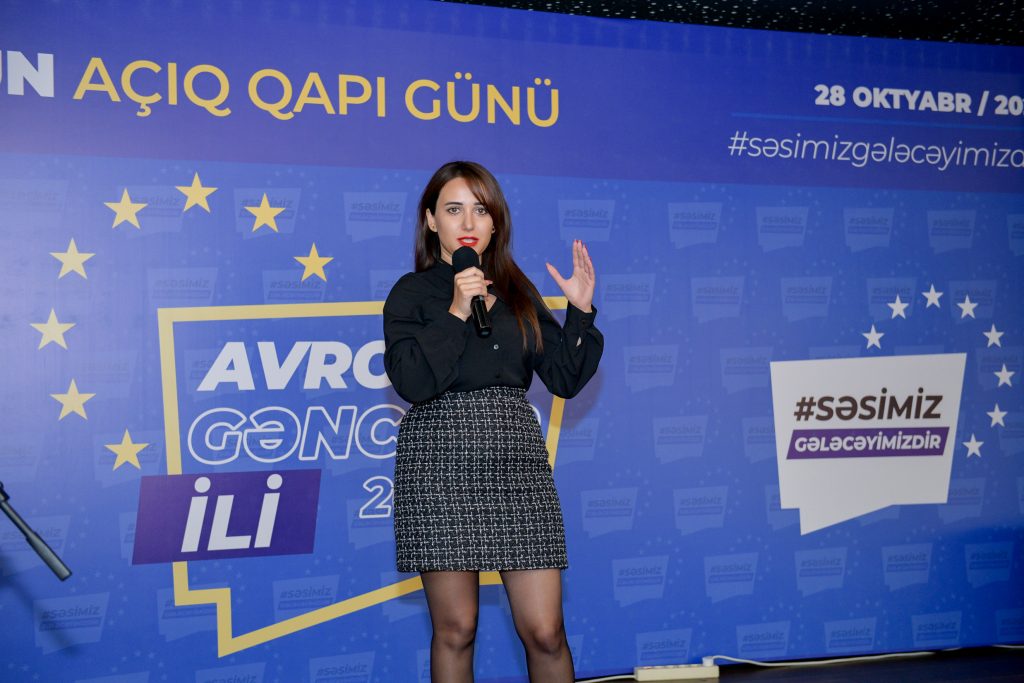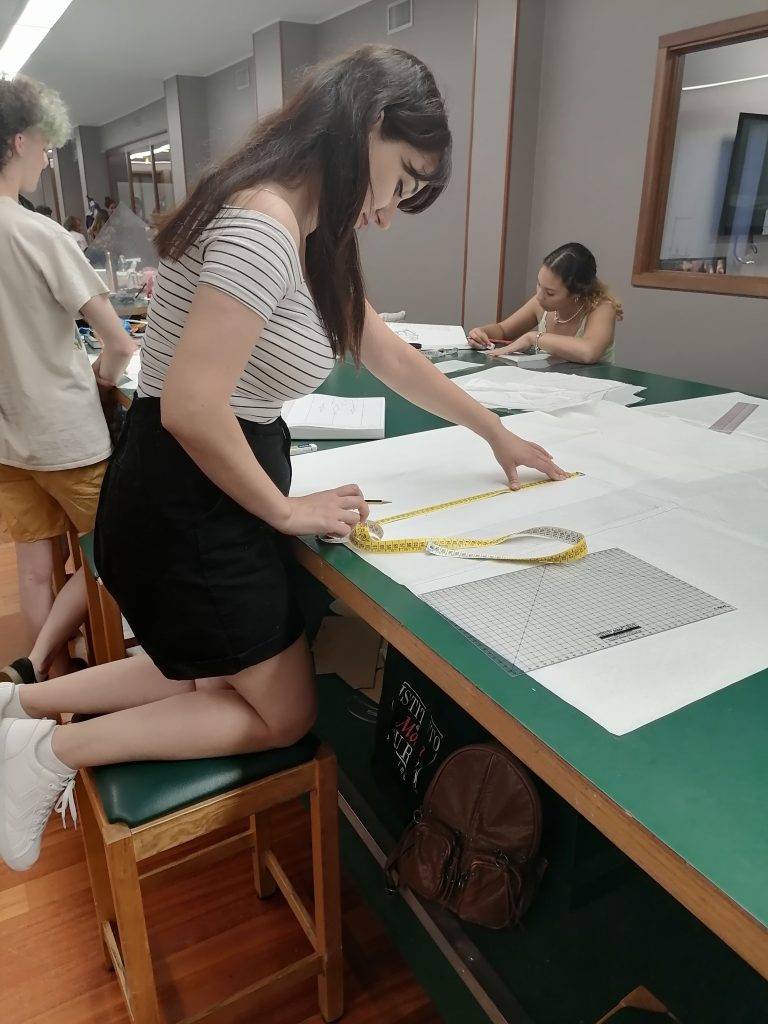Italian watch

Aytan Khalilzada, a young fashion designer and RozSev brand creator, underwent a one-month fashion design course at the Instituto di Moda Burgo, a private school of fashion, in Milan last summer, after receiving a mobility grant under the EU4Culture project.
– What did you bring from Italy?
– A watch.
– Why a watch?
– It was available at a discount.
Then she carefully winds that watch and adjusts it on her left wrist. I look at that item, decorating her left hand, and repeat the first question.
– What did you buy in Italy, what did you take home?
She pauses on this matter for a while, then answers in a different voice as if she were cheerful hearing that question:
– I brought emotions – they are second to none.
After that answer, I look at her new wrist watch again and sense that Aytan has synchronised her work schedule with Italian – or more precisely – Milan time.
Floating on the clouds
Finally, she got aboard a plane and consulted her watch. It was 7:30 in the morning of the 2nd of July 2022. It was her birthday – she was turning 30 years old that day. She closed her eyes and surrendered herself to the feelings of happiness and joy. She could not believe that she was floating on the clouds…
At the same time a couple of days ago, she neither had a visa nor an airline ticket. However, she took a big risk – a week earlier she transferred the course fee prior to obtaining the Schengen visa and buying the airline ticket. As a matter of fact, she bought the airline ticket only yesterday.
All but her family remained unaware that Aytan was traveling to Milan. Oh yes, there was one more person – her contact at a travel agency who warned Aytan that ‘only two tickets had been available for the 2nd (of July), so if you fail to buy on time, then it could be too late.’ Her courses were set to start in three days, on the 4th of July 2022. That’s the whole story about buying the ticket yesterday and ending up aboard the plane today.
Floating on the clouds she was marking her birthday with new friends – an Italian family who she had not known before getting on a plane. Aytan faced the paradox of a zero command of the Italian language while her friends could not communicate with her in English. However, it was the body language that helped all to understand each other very well. For Aytan, that exceptional birthday experience was very long, probably taking years, in coming. Could it be a turning point in her dream of becoming a fashion designer?
The start of a dream
It all started long ago… An eight-year-old girl was sitting at home and stitching a wedding dress during a long-lasting summer school holiday when youngsters, including her peers, were playing outside.
That little girl was a smart one – she drew a picture featuring the wedding dress of her uncle’s fiancée.
The girl soon changed her mind and abandoned stitching. She grew interested in drawing clothes. Her imagination did not recognise any border, for she produced unusual, even extravagant sketches. She did not mind if any of her drawings would translate into apparel.
Her mental outlook was very broad although she never departed from her native Mingachevir [a provincial town in the central part of Azerbaijan – Ed.]. As she grew up, she thought of herself as a fashion designer. When she applied to the (Azerbaijan State) Art Academy, she thought she was just one step forward to having her dream come true. They, however, say, ‘man plans, and God laughs.’ That year saw an elevated threshold for admission exam scores. Consequently, Aytan had to say ‘goodbye’ to the Art Academy, and in order not to upset her mother, chose a different major – history at Sumgayit State University, for which her exam score made her eligible. She confronted reality, with the dreams moving to the background.
In reality
From a volunteer to a managerial position, she did different jobs while continuing her education. In a nutshell, she was not afraid of (hard) work. What did not change over the past years was Aytan’s propensity for drawing fashion sketches. Something, however, happened one day – Aytan was tired of seeing her drawings remain on paper, or she was simply tired of drawing without practical results. She set herself a goal of changing her world. The same year she was a newbie attendee at the Creating an Apparel Brand training course at the Istanbul Fashion Academy (IMA) in Turkey. That turned out to be an eye-opening experience for her, for she learned a lot about brand-building requirements. Furthermore, she learned the unvarnished, ultimate truth that a genuine fashion designer must learn sewing. She spent the following two years mastering that craft by combining learning with practicing. She sewed items for herself, family members, and even her mother’s colleagues.
She has realized a golden rule ever since – to value herself and her work. If you undertake to do something, you need know the value of your corresponding performance. There is no point in committing yourself to anything you would not want to do.
She also learned her business wins and losses – what was measured by scissors was not always the exact response to value-based pricing needs. Subsequently, RozSev became her first live business case.
Emergence of RozSev
In 2019, upon becoming a beneficiary of the United States Agency for International Development’s (USAID) project to support women entrepreneurs in Azerbaijan, Aytan decided to build a brand incorporating the names of the two people she liked most – her paternal grandmother Roza and her mother Sevinj. Consequently, Aytan rented a space, refurbished it the way she wanted and transformed it into the RozSev office. Maybe that decision came out of her love for them, or her lack of experience.. She started but endured the COVID-19 pandemic soon afterwards. Her resources, including investment and labor, seemed to have been spent for nothing since the office remained closed for months. Aytan did not even consider that unprecedented risk, but she did not give up. She started every day of the week watching cartoon movies and imagining herself in the shoes of her heroes, looking like them. that was a major booster to refresh her mind and focus on solving the problem that confronted her. Subsequently, she changed her mind and embarked on social projects. As a matter of fact, reaching out and helping people with physical disabilities was Aytan’s longstanding ambition. So she did not hesitate at all to join the self-employment program announced by the Ministry for Labor and Social Protection of the Population. She proved herself to be a program recipient: the two sewing machines she had received doubled the already installed capacity in her office workshop. The hardest part of what she was required to do laid ahead – she had to identify people with disabilities, on whom the COVID-19 pandemic had a negative impact, then teach them how to sew, thereby giving them an opportunity to earn their own bread and butter.
– Sometimes you cater for a hundred people but choose only one who qualifies for (what is required). The pandemic added more challenges. Despite all the difficulties, Afsana has turned out to be the most important asset, a real find for my social project. She comes from Afar, Sangachal has hearing loss but is quick in the uptake of what I am saying. She is responsible. Finding the right people is crucial for any business to prosper. I am not at work all day, for I attend different training courses, have meetings and engage in tenders and other competitions to develop my business and further build it up. I get to know new people, make new acquaintances, and spot new openings as they pop up. My second golden rule is to build and constantly develop my network. To an outsider, this looks a bit strange as though I am involved in something that goes beyond the framework of fashion design. In fact, nothing ventured, nothing gained – whatever activity l am taking on is to support my business.
Chasing ‘mobility’ down
– When I dived into the EU4Culture Project, funded by the European Union, last summer, I was wearing another hat – a participant in the Access to Success project sponsored by AccessBank. I was so busy that I could snatch only half an hour to prepare my portfolio proposal and submit it on the final day. That was the final stage, and I did not have much hope for a lucky outcome. However, my achievement was to the credit of Kristina Mammadova and Jeyhun Farzaliyev, my mentors. Meanwhile, it happened that winning was half the work – administrative barriers, precisely registering my project grant with the Ministry of Justice and obtaining a Schengen visa from the Italian Embassy, were not straightforward to overcome. When I almost despaired of receiving the Schengen visa, I clung to the hope that a letter to the embassy could swing things around. A call from the embassy was not far away – on the same day, they got in touch with me and made the long-awaited appointment for the following day. It was an icebreaker experience that paved the way for the remaining activities to undergo at lightning speed. When I was aboard, I had not slept for over a day. You wouldn’t believe that problems lingered on – they accompanied me from the plane’s landing to my arrival at my hotel. There, at the hotel’s entrance door, I asked myself, ‘Aytan, was it worth it?’
Really, was it worth it?
Yes, it was.
In Milan
– It was worth withstanding and overcoming all the challenges for the sake of seeing Milan. Milan was the city of my dreams; for me, as a fashion designer, one-month study in Milan meant that my biggest dream was coming true thanks to the mobility grant I had been awarded. It was in Milan that I was out of my comfort zone for the time in my life. I started afresh and learned how to find my feet and stand on them. I valued every single aspect of the fashion design course which I was attending at Instituto di Moda Burgo. We studied sewing and fashion design four days a week, every day from 9 o’clock in the morning till the afternoon, in two different branches of Instituto di Moda Burgo. Sometimes fashion design instructors swamped us with sketching assignments, so I could only accomplish them at the hotel. Occasionally I was under the impression that our instructors overburdened us, yet I did not blame them since the course was lovely and intensive. Besides, my performance depended on my progress in my studies, so I had to do well at them. There is a difference between the Italian and Azerbaijani ways of measuring and cutting. I spent the entire week on stay stitching, my tender point. Acquiring skills in stay stitching and formula-based, cast-in-mold sewing patterns were my biggest gains from the course. The formula has been known to me ever since…
Aytan pauses, but I think it would be excessive and unnecessary to ask further questions. Why should I? She knows how to get a formula – perhaps that skill guides her work schedule synchronized with Italian time.



